Towards Minor Literary Forms: Digital Literature and the Art of Failure
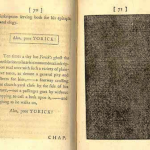
In this keynote address to the 2014 Electronic Literature Organization Conference, Illya Szilak highlights the power of "minor forms" in digital literature. Through a wide-ranging survey of works, Szilak identifies the tendency for "failure" in electronic literature as its most powerful feature: its capacity to deterritorialize the parameters of discourse and expand the potential of subjectivity in the process.
Note: This essay was presented as the keynote talk at the 2014 Electronic Literature Organization conference in Milwaukee, WI.
As a poet friend of mine pointed out: literature, in so far as it is relates to the digits, the fingers, the act of writing, has always been digital. Moreover, all writing, conventional or electronic, begins with digitalizing analog experience. To ask what digital literature is then is to ask how this process changes when the means by which we read and write change. If we can answer that, we can understand how digital literature differs from and is similar to conventional literature, and, why, hopefully, it is doomed to failure.
Certainly, the most apparent difference between conventional literature and digital literature or E-lit is the latter’s hybridization of text, image, moving image, and sound. But, illustration, the symbiotic combination of text and image has been around since illuminated manuscripts, and each day thousands of blog posts employ multiple media. So, are these digital literatures? Not necessarily. John Cayley has suggested that digital literature is not a genre of writing, such as playwriting, fiction, etc. but rather a particular mode of practice (Szilak). In this essay, I will argue that this mode of practice is one that unmasks the mechanics of language and meaning-making through the revelation of its own “machine-works.” Thus, broadly considered, it is not limited to computer-age writing. One example is Tristam Shandy (1759), which was included in Dene Grigar and Kathi Inman Behren’s exhibition Electronic Literature and Its Emerging Forms at the Library of Congress in 2013, confronts the reader with a completely black page (Grigar).

The Black Page from Laurence Sterne’s Tristam Shandy
What can’t be appreciated from the jpeg is that Sterne purposefully had it published with so much ink that it leaked through to the other side. This is no longer an image, but an infra-thin sculptural object. Another pre-computer age antecedent that demonstrates a “digital” use of image is Andre Breton’s Nadja (1928) in which he paired banal, generic photographs of Paris with intimate, diaristic prose.
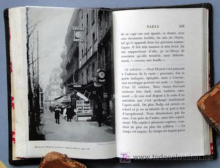
Photograph in André Breton’s Nadja
Here, as in Tristam Shandy, image does not merely complement text, it disrupts the smooth workings of it, revealing the material effects and the physicality of text as medium. Similarly, in “Typewriter Revolution,” D.J. Enright utilizes the “glitch” potential of the typo to destroy the analogue experience of reading and writing, revealing its mechanistic, digital foundations.
What does this mode of practice have to do with failure? Another pre-computer example of digital practice, “The Sandman” (1816) by E.T.A. Hoffman will help illustrate. In this short story, the anti-hero Nathanael falls in love with, Olympia, a robotic woman, whom he views from afar through a spy-glass. Technology occupies an uneasy and ambiguous position in the story. Although it extends the resolving capacity of human perception, it also fractures, obscures, and destabilizes the fixed “reality” of the user. For Hoffman, language, itself, is a kind of technology, one that allows individuals to communicate their private thoughts and emotions, but which repeatedly fails to accurately and fully simulate the reality it attempts to describe. Moreover, it is this failure to communicate without error that distinguishes “human” from machine. In fact, Nathanael’s peers use misspeaking and impolite bodily gestures like sneezing and yawning as confirmatory signs that their lovers are not just “wooden dolls” (15).
Notably, “The Sandman” begins with a failure (Nathanael accidentally sends a letter meant for his fiancée, Clara, to her brother), and it is punctuated throughout by the characters’ inability to write, to speak, and to see. In fact, the story of “The Sandman” consists less of a straightforward plot than a series of simulations and revelations in which the designation of human vs. automaton, true vs. false, largely depends upon the subject position of the viewer, as well as on his or her use of technology. Thus, at times, Clara appears as an automaton to Nathanael, and, Nathanael, his viewpoint distorted by love, does not see what others see, that Clara’s rival Olympia is actually an automaton. In this way, “The Sandman” acts as a kind of literary machine, one whose function is to put into play binaries: analog and digital, human and machine, and failure and mastery. Again and again, Hoffman uses his mechanical creation, his Olympia, to generate states of aporia—doubt and uncertainty where these contradictory terms seem to coexist.
The word “fail,” originates with the Latin fallere meaning to deceive. Thus, failure is linked to the concept of the simulacrum. According to Michael Chamille, what disturbs Plato about a “simulacrum,” is not that it is a lesser version of the original, that it to say a copy, but that it is an entity that exploits the deficient (limited) subject position of humans and our limited experience of reality to produce the experience of the real such that we cannot distinguish between real and simulated. A simulacrum is a copy that has assumed its own status, and in so doing, it has failed to be a “good” copy (Sandoz).
Some readers may remember Andrew Gallix’ article in The Guardian newspaper in 2008 which suggested that digital technology, although seeming to afford endless avenues for literary experimentation, actually, is “one big anti-climax.” Gallix’ assessment, however is based on an erroneous assumption. Rather than appreciate digital literature as a unique art form, he makes conventional literature the standard by which its success is measured. Digital literature is seen as a failure, because despite its name, it is not literature, but a simulacrum of literature. It might look a lot like it, but it actually operates very differently. In so far as it is not at all a good copy of the model, it will inevitably be seen as a failure.
To understand how failure and the concept of the simulacrum relate to the practice of digital literature, we will need to explore the relationship between the analog and the digital. The key distinction is that analog is a continuous variable while the digital is composed of discrete values. In analog systems, there is no “truth” function, no negative, and no zero. The digital, on the other hand, lends itself to binary pairs that are both distinct from each other like 0’s and 1’s in computer code, and often opposed to each other like good/bad; true/false; real/artificial.
In System and Structure: Essays In Communication and Exchange, Anthony Wilden likens the process of going from analog to digital to the solidification of difference into distinction (159). For Wilden, human communication has both analog and digital aspects. Broadly, “analog” is descriptive of what might be called human life or real experience whereas “digital” is a more apt description for machine-like life or conceptualized or abstract experience (Table B, 192-193). Wilden, following Gregory Bateson, puts words squarely in the digital column. But, is this appropriate? It’s clear that in so far as they create distinctions, words, at least on the surface, are digital. However, words do not exist out of time. A word is not a static container for meaning, but rather a little apparatus that is not only marked by its own history as etymology but also by the reader’s personal experience with that word. Moreover, the meaning of a word and even the perception of how it sounds are influenced by the other words around it. Thus, it is absurd to say that words are purely digital. Moreover, the very use of the terms analog and digital, in creating oppositional binaries, essentially digitalizes what is both an analog and digital process namely human communication and language.
In response, Carol Wilder offers her own playful chart, which shows binaries based on her friends’ understanding of analog and digital. (245-246) Thus, Valentine’s Day is analogue while The Fourth of July is digital, Coney Island is analogue while Disneyland is digital, and a Big Mac is analogue while Chicken Mc Nuggets are digital. For Wilder, “the analog/digital pair in the end is itself as digital as binary opposites and as analog as the relationship between them; as intertwined as the desire and technology of our actual and virtual lives and the new era they are creating” (252).
As the world moves more and more from an analog reality into one encoded by 1’s and 0’s, it is clear that the stories we tell ourselves have become more fixed (religious fundamentalism, nationalist and ethnic mythologies) and, at the same time, more indeterminate. Binaries are breaking down. The system of discrete entities, which is the sine qua non of written language, a system which generated the terms “prototype” and “copy,” “human” and “machine” is being replaced by a different form of simulation characterized by the proliferative logic of the simulacrum. Thus, for writers of digital literature, the choice is not between analog and digital forms of communication, old and new media, the “real” and the “virtual,” but rather how we will negotiate and release them from their binary capture. Because digital literature is both “born digital” and “literature,” it is in a unique position to act as a laboratory. The repercussions of this experimentation, I will argue, go well beyond the art of writing to conceptions of time, politics, gender, and the very notion of what it means to be human.
In Kafka: Toward a Minor Literature, Deleuze and Guattari discuss the creation of what they call a minor literature. Whereas, in the modern era, the ideal of an artistic genius creating a masterwork marked by an exquisite personal style or vision dominates, with Kafka, you find something quite different. Here, the work is created as a kind of mechanism, which alters experience and produces affect in the reader. In other words, the story or novel is not a finished product but a process through which the actual, living work is created. Moreover, in minor literature, the political overrides the personal. Although content may be personal, what the literary machine does, what it effects, is where significance lies. In minor literature, everything takes on collective value (17-18).
An excellent example is Kafka’s bizarre little short story “Cares of a Family Man” (Delueze and Guattari 40). In it, the writer contemplates a thing that somewhat resembles a spool of thread, which, although seemingly a “person,” after all it has a name, seems also to have no use, no purpose and no meaning whatsoever. This animated thing which is not exactly human or object, male or female, insignificant or significant, elicits a terror in the family man because he suspects that underlying all the rigid and elaborate structures of his life, there is no meaning, only nothingness, a void. Minor literature finds its subversive power through a delicate process of both maintaining and undermining the dialectical logic of the digital. This power rests in a re-inscription, an analogizing of binaries, such that failure is recoded as potential. This is the logic of the simulacrum. The examples of digital that I will offer adopt this logic. Their potency resides in a “strategy of failure.” These strategies include the use of “minor” languages such as ads, melodrama, kitsch, misspeaking, creole, private and non-signifying languages, the execution of “minor” forms of political action such as refusal, drag, humor, play, and other modes of practice which emphasize glitch, inefficiency and inconsistency, embodiment and temporality.
An excellent example of the minor language strategy is Talan Memmott’s Twitter based series of mashup ads The Digital Culture Lecture World Tour. The Digital Cultural Lecture Tour brings into question not only what is literature, but several other binaries: public, private; work, play; information, noise; success, failure; high art, low art. In recoding the dominant and minor terms, Memott undermines the “naturalness” of this hierarchy, and opens up the possibility of writing and reading these terms differently.
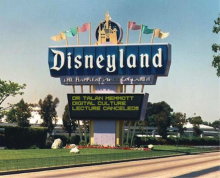
Image from Talan Memmott’s Digital Culture Lecture World Tour
Interactive fiction (IF) is a game form of literature in which the player uses text commands to control a character and move through an environment. As in the real world where language is used to delineate objects and define spaces, in IF, the vocabulary of the parser literally defines the world of the game. IF creates a situation in which the binaries of author/reader, self/other are constantly in flux. Playing a work of interactive fiction is a process of exploring, interrogating and revealing the mechanisms/rules by which language and meaning making in the game operate.
Emily Short’s take on the Cinderella story, Glass is set in the home of Cinderella’s stepmother, the morning after the ball. Cinderella, herself, does not participate in the dialogue. She remains perfectly silent, unable or unwilling to speak the truth as the prince tries the glass slipper on her ugly stepsisters. In a wonderfully subversive move, Short displaces the truth-telling voice onto a caged pet parrot in the living room. The valid operative terms are restricted. A player can’t come right out and tell the prince he’s being fooled. The parser recognizes the verbs “say,” “sing,” “poop,” and “fly,” and “preen,” but not “fold,” “fluff” or “peck.” You can say: “love,” “Cinderella,” but not “liar” or “stop.”

Screenshot of Emily Short’s Glass
In so far as the interactor’s position in IF exists on the boundary between human: machine and self: other, it occupies what Julia Kristeva calls “the abject,” a condition in which there is a breakdown in meaning caused by the inability to distinguish between subject and object or self and other. “It is thus not lack of cleanliness or health that causes abjection but what disturbs identity, system, order. What does not respect borders, positions, rules” (14). Thus, what drives the player to explore/map the world, discover the story, and solve the puzzle is both a childlike desire to play and an adult imperative or compulsion to find order and re-establish boundaries through language.
Mez Breeze and Andy Campbell’s Dead Tower concretely illustrates what Deleuze and Guattari call the “deterritorializing” aspect of minor languages.(16) In this work, the user wanders in the dark trying to make sense of the 3-D game space. There are few clues and little narrative save for the trope of being lost and needing to find a way out. Along the way, the user encounters fragments of text which, because they have computer code embedded in them, serve as labyrinths, both providing a structure and direction to the experience while, at the same time, complicating it.
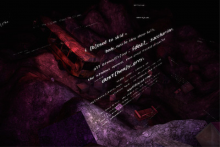
Screen Shot of Breeze and Campbell’s Dead Tower
With her “mezengelle” language, Breeze creates a minor language that combines the dominant languages of humans and machine—a kind of creole that disrupts the prescribed utility of both word and code, “deterritorializing” them, and opening them up to new meaning and play.
Alan Bigelow’s My Life in Three Parts looks at identity as it is mediated through software and asks the question, what do our identities look like on the Web? In part one, Bigelow pairs products he has purchased with Twitter sized poetic commentary. In the second part, he pairs images of famous artworks with humorous comments, not at all in keeping with the gravity of these masterpieces. In this way, Bigelow prompts viewers to consider whether or not the massive circulation and reproduction of the image has indeed stripped away the importance of these artworks.
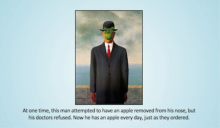
Screenshot from Part Two of Bigelow’s My Life in Three Parts
In the third part, Bigelow counts the number of times he has done certain things like cried, laughed, and had sex. He ends his reckoning with the number of times he has died (zero), and, in doing so, returns his multiple simulated, distributed identities back to a singular, but perhaps incomparable one. My Life in Three Parts is the opposite of big data. Although, all of the facts are true, they in no way come close to capturing the complexity of Bigelow’s life. And, it is this failure, which makes the work so affecting.
Perhaps the most profoundly minor language is one that is non-signifying. Such a language can be linked to Heidegger’s concept of “profound boredom” a state in which all beings “recede” into indifference, and the one who is bored comes face to face with the experience of time itself (80). Here, meaning-making that previously served to mark time is emptied out. It is in this state of abject indifference that language, which creates distinction, fails. In profound boredom, even distraction, which could have, if not marked, at least effaced time, is futile. It is precisely this experience that humans find so discomfiting. Operating, as we do within language, and the digital binaries of life and death, existence and nonexistence, chaos and order, profound boredom leads us, like Kafka’s family man, to suspect that, at the core, there is nothing there.
We can look at non-signifying languages another way, in terms of information transfer. As Wilden notes: information must be distinguished from signification. “Without a high degree of ‘existential redundancy’–the constraints of the specific code of communication, codes of behavior, particular lexicons, contexts, intentions, the actual relationship between the sender and receiver, and so on—there is no signification.” (234) Information is not concerned with the systems (sender and receiver), which process it. Meaning, on the other hand, is. Thus, information is necessary for signification, but not sufficient.
Tan Lin’s Plagiarism/outsource: notes towards the definition of culture : untilted Heath Ledger project : a history of the search engine : disco OS, which nominally concerns itself with the death of actor Heath Ledger employs a language of meaninglessness. By radically disrupting the expected codes for a novel, using disparate sources, and democratizing information, Lin destroys Wilder’s “existential redundancy” (234). The entirety of Lin’s novel consists of a patchwork of “plagiarisms,” ranging from whole pages of a J. Crew catalogue to Lin quoting himself. By so thoroughly destroying signification, Lin’s Heath project leaves the reader bereft. At the same time, the novel as novel overtly challenges the reader to make meaning in the face of this state of profound boredom.
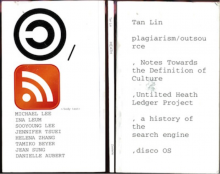
The Cover of Tan Lin’s HEATH.
If the reader lingers in this state a while, out of this void, something else emerges. Heidegger describes profound boredom as the ground for all the multifarious variations of being (82). I would suggest that for Lin, it is also the ground for poetry. The experience of the Heath project is unexpectedly poetic. As Danny Snelson notes, the poetic experience begins with the peculiarity of the spine title “Heath” (who, lacking a family name, will remain “unledgered”), and the addition on the front cover of the word “untilted” meant to be misread as untitled. However, a Google search for the word, soon reveals a hidden encrypted, networked meaning that references the 8th album of the ambient, glitch band Autechre. In HEATH, signification and meaning arise as a networked form of poetry.
In the same way that Heath Ledger, the celebrity, continues to exist without a body, Lin’s HEATH repeats the radical effacement of embodiment. The real human with his mortal body, has been replaced by information. Moreover, the growth and development of this information body is no longer encoded by DNA and the expression of RNA, but by the algorithm of the search engine. Just as on the Web attention supplants meaning, in HEATH, obscurity supplants mortality. Overlooked, or incorporated, the physical body has no more significance than any other piece of data. If the body is incarnated in HEATH, it is as book, a static thing where the information flows have congealed and petrified. As Snelsen puts it: “the emphasis on error, original formatting, unfinished (unpolished) writing, and a sense of the incomplete characterize the temporal qualities of the book: a meditation on ephemerality, presence, and forgetting.” Online, the messianic promise of the virtual is the promise of losing the body entirely, escaping mortality and finitude. It reflects our desire for an impossible state wherein we may somehow eliminate redundancy without sacrificing significance. As we know from information theory, and as Lin’s work beautifully demonstrates, this is a dream bound for failure.
Like, Lin’s HEATH, J.R. Carpenter’s work involves a flattening of the landscape of storytelling. However, instead of democratizing everything and ablating the body, she reinserts the body back into the landscape by fabricating hybrid places that are both “virtual” and attached to real world locales. If Lin’s is a work without a map, J.R. Carpenter’s can be thought of as a form of Debordian derivé.
Just as the body of a walker must accommodate the obstacles in a city, in Carpenter’s work the reader is required to move around existing structures. Of course, on the Web, it is not physical landmarks and natural boundaries that orient us, but the patterns in which data is organized and presented which, in turn, depends upon code. Of note, Carpenter is one of a number of digital writers who writes her own code.
In CityFish Carpenter combines intimate details, both autobiographical and appropriated, of characters’ lives with real-world maps and photo and video “documentation.” Readers wander through a narrative landscape in which Cartesian perspective has been lost and which objects co-habit in a way that makes sense only in the context of the artwork. In experiencing Carpenter’s work, the reader is constantly aware of the tension between “real” existence, that is to say, embodied space, and the new virtual spaces opened up by the Web.

Screenshot from Carpenter’s CityFish
With the move from analog embodied existence to virtual, digital existence, our perception of time, too, has changed. Once tied to the seasons and to farming, time began shifting into abstraction with industrialization. Online, time seems eternal. We become aware of it, only when something is slow to download, that is to say, when the system breaks down. In A Theory of Time Here, filmmaker Roderick Coover and his collaborator, writer Deb Unferth make a radical advance on Gertrude Stein’s repetitive use of language in The Making of Americans. In Stein’s work, despite the loss of syntax, some meaning remains. Moreover, Stein offers listeners an alternate syntax —musicality. Coover and Unferth’s piece gives their viewers no such respite. Here, there is no signification or pleasing tempo, only an infernal marking of the passage of time as the computer monotonously reads Unferth’s text. Moreover, Coover’s visual recordings of time moving at various speeds: cars passing, pedestrians waiting at a stoplight, buildings enduring serve to undermine whatever numbing satisfaction the uniform rhythm might have provided. The resulting experience is both disorienting and physically painful. In this way, Coover and Unferth return time to the body, offering a visceral reminder of human finitude, a finitude intimately linked, not only to the materiality of the body, but the materiality of all information. As N. Katherine Hayles reminds, “conceiving of information as a thing separate from a medium that instantiates it is a prior imaginary act that constructs a holistic phenomenon as a matter/information duality” (75).
Another work that explores the inescapable materiality of information, non-signification and boredom, albeit in a very different way, is Nick Montfort’s algorithmic poem “Round.” Here, the computer calculates digits of Pi in real-time and replaces them with one of 9 words or a line break, thus creating an endless and ever-slowing poetic engine in which increasing time and energy is required to perform the operations.
The second general strategy of failure we find in digital literature is what I call minor politics: forms of resistance that do not directly oppose the dominant term in a binary, but rather refuse to take that term seriously or simply refuse. Deleuze and Guattari suggest that minor literatures are inherently political because it is not the content so much as what they effect that matters (17). That effect is difference in the analogue sense, not distinction in the digital sense because what it effects is a loosening of perception, without necessarily leading to distinction, that is to say, a definitive product or outcome. One might say that it leads to a particular kind of indifference, an impotency that refuses to get to the business of definitively organizing the real. This, of course, relates back to Heidegger’s theories of profound boredom. A related idea is Heidegger’s notion of the misuse of technology to keep humans and nature as standing reserve, always at the ready for productive use (17).To resist this, George Bataille offers a form of im-potentiality that he calls desoevrement or “worklessness.” (19) “Worklessness” here should not be misunderstood as merely a slacker mentality. Rather, worklessness is a repurposing of the productive and reproductive functions of living not for some finite end or product, but for play. For Bataille, the making of art for art’s sake is an important form of this.
Repurposing Bartelby the Scrivener’s subversive utterance, “I would prefer not to” for the Internet Age, Gabe Smedredsman’s Anchorage, is a narrative game devoid of authorial narrative. Here, the player allows the game to access her emails. This data is then set up as a timeline, the banks of the flowing river that you see here. Each discrete email address including the player’s own is represented by a different sailboat . As the player’s boat sails along, other boats corresponding to people she has corresponded with join her on the journey. A little clock shows how much time the player has left with each boat/correspondent. When no further emails are exchanged, time is up. The correspondent’s boat is left behind and the player’s boat sails on.
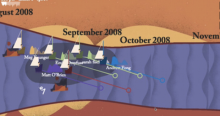
Screenshot from Smedredsman’s Anchorage
Although, Anchorage has even fewer hallmarks of literary genius than Kafka, it nevertheless has the potential to invoke profound narratives in the player. For instance, when I played it, I was struck by the fact that in 2009, I sent almost no emails, and the ones I did send were to people whose names I no longer recognize. I tried to think what might have happened to create such a circumstance. I remembered that in 2009, I went back to work as a physician after taking time off to have children. I remembered the isolation and loneliness. Suddenly, however, in 2010, other boats join me. I recognize them all as parents of my children’s friends. Anchorage hints at the possibility that not writing is a new kind of language, which, in place of phallocentric inscription, creates hollows for contemplation and storytelling. In fact, it is precisely this game’s incompleteness, its surface “inadequacy,” that allows it to resist the normalizing, surveilling tendencies of software.
Drag is another minor political strategy, one that is facilitated by the way identities are constructed on the Web. Drag is a form of what Donna Haraway calls cyborg politics: “Cyborg politics is the struggle for language and the struggle against perfect communication, against the one code that translates all meaning perfectly, the central dogma of phallocentrism. That is why cyborg politics insist on noise and advocate pollution, rejoicing in the illegitimate fusions of animal and machine” (180).
In my latest work, Queerskins, I explored the politics of gender through a kind of literary drag performance, in which I mingled scenes and feelings from my own autobiography with that of Sebastian, a young gay physician from a rural Catholic Missouri family who dies of AIDS at the beginning of the epidemic. When I presented this work to a class at Bard College one woman asked if I was concerned by my failure to speak (that is to say adequately copy the voice of a real gay man). I said that it had never been my intention to “fool” anyone, for what power would that have had, except as some sort of neat trick. My actual intention had been to sort of fail and sort of succeed, so that the terms themselves, male, female, straight and gay would become problematic.
Playing with binaries: self/other, fiction/nonfiction, male/female, virtuous/perverse, I paired Sebastian’s highly lyrical intimate diary entries with utterly ordinary images culled from Flickr Creative Commons. In Queerskins, I was interested in thinking through how meagerness, smallness, and quotidian, embodied existence can be seen not as, “castrated” forms of a mythic or heroic ideal but as the grounding for “mutation,” the multiplicity of life whether virtual or embodied.

Screenshot from Szilak’s Queerskins
In the diary entry below, Sebastian describes his breakup with his first lover. When I read this for an audience, I try to dress ultra-femme. In performing it, I consciously invoke this shift in subject position of a “female” speaking as “male” who, in this scene, is speaking as “female.”
“Do you want it?” you asked and there was a gunmetal glint of meanness in your eye.
I nodded. A slug’s trail of snot, slipping from my nose. I wiped it with my hand.
Your eyes narrowed with disgust. Then you went up to me and placed a cupped hand on my jeans and pulled my chin to yours to kiss me, your lips tasted like salt and your breath was stale like potato chips and beer, but I was immediately hard.
You stroked a little and I moaned. You’d brought your bag of tricks. That black Adidas bag. I never knew what you’d conjure. You pulled out a dress and a pair of nude panty hose and black leatherette sandals that were too small because they were your mother’s and though she’d been fat, she’d always had small feet. But, you wanted more than submission, you wanted abjection. I would have protested, a voice in my head started, but, oh how I wanted to taste you in my mouth, once more. And you’d found some old lipstick and pancake or stole it. And, made me up—skin like a geisha with rose bud cheeks and a mouth like a cunt. I would be lying if I said I didn’t enjoy it.
In their essay, “Shame and the Cybernetic Fold,” Eve Sedgwick and Adam Frank suggest that shame creates a fluid boundary between normalcy and perversion. It “is one of those digitalizing mechanisms that works to punctuate the system as distinct. Perhaps along with contempt and disgust, it can be a switch point for the individuation of imaging systems, of consciousnesses, of bodies, of theories, of selves, an individuation that decides not necessarily an identity, but a figuration, distinction, mark of punctuation” (22). Indeed, when we think of “pride” in the context of queer politics, we can see that it is an attempt to re-inscribe, or re-clothe, shame by turning it into or dressing it as its opposite. Both pride and shame recognize the boundary that is being transgressed, and both refuse to renounce the object of desire. This refusal is, in the scheme of things, a minor political act, were talking rainbow flags here, not Molotov cocktails, but as we have seen, such minor political acts can be incredibly powerful.
Humor is another minor political act, a play form of violence. In comedy, the self of the comic, unlike the self of the warrior, is legitimated not through the bodies of victims but through the laughter of the crowd. The power relation is complicated by the fact that the comic at once holds captive the audience and requires the audience to “kill” her with a volley of laughter thereby bringing her into existence as comic. Thus, in comedy as in war, the other is absolutely necessary for without the “Other,” there is no potency. It is because humor, especially, slapstick recognizes the vulnerability of bodies to violence, that it takes its mimetic aim in exactly these terms. The prize of the dominating “I” is sacrificed (willingly made a victim) for the power to remake the terms of power/violence through mimesis. In his Comedy of Errors album, Mark Amerika uses ‘the joke,’ which is both a base language and a minor political act, to take on real sources of violence and repression.
In a similar way, Jason Nelson disguises his acerbic political critique in a “frivolous” form—the computer game. When asked about the political nature of his work. Nelson invokes a strategy of failure: “As a digital poet I want to break things, to make code and interface, language and media, software and net-lands do things, respond in ways they weren’t intended to function. To take the expected response, the stimulus of reward and jumping and destroy or rethink or corrupt or caress its most sensitive parts” (Szilak). Like much of Nelson’s work, Game, game, and again, game addresses the dominance and demise of “big systems”—in this case failed belief systems ranging from Christianity to capitalism. Although the interactive schema is familiar (my 6-year-old quickly learned how to maneuver a hairy creature through a dangerous terrain of scribbles and “poorly drawn bits”), Nelson destabilizes and complicates the game by rewarding the player’s actions, not with points but with fragments of poetry. Rather than place poetry in opposition to technology, however, Nelson uses language as an adjunct technology, a means to create an additional play space, in which, since it exists only in the player’s own mind, the rules no longer apply.
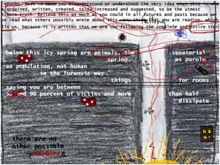
Screenshot from Nelson’s Game, game, and again,game
Today, we are negotiating not only what our digital identities look like, but also the very notion of “self” and other, “human” and “machine.” As I’ve tried to show here, digital literature is at the forefront of this negotiation. To a certain extent, digital literature has been locked up in an ivory tower of academia where it threatens to be crushed under the weighty designation of “digital humanities.” I sincerely hope this does not happen. It’s human to want legitimacy, but might I suggest that rather than agree to these terms legitimate and illegitimate, writers of digital literature seek to become “illegitimately legitimate” or “legitimately illegitimate” and in doing so, create an alternative, more open, fluid system for artmaking, criticism, education, and economic exchange. To quote Brian Massumi, “The other mode of simulation is the one that turns against the entire system of resemblance and replication. It is also distributive, but the distribution it effects is not limitative. Rather than selecting only certain properties, it selects them all, it multiplies potentials: not to be human, but to be human plus. This kind of simulation is called ‘art’” (5).
Works Cited
Amerika, Mark. Comedy of Errors Album. Museum of Glitch Aesthetics. Website. http://glitchmuseum.com/thecomedyoferrors.html
Bataille, Georges. The Accursed Share: Essays on the General Economy. Vol. 1. Website. http://dm.ncl.ac.uk/courseblog/files/2011/03/Accursed-Share-Volume-I-The-Meaning-of-General-Economy-Bataille.pdf
Bigelow, Alan. My Life in Three Parts. Website. Webyarns. http://webyarns.com/MEME2/meme2.html
Breeze, Mez and Andy Campbell. Dead Tower. Website. Dreaming Methods. http://labs.dreamingmethods.com/tower/
Breton, André. Nadja. Grove Press. 1960. http://books.google.com/books/about/Nadja.html?id=GUP9PswhdKQC
Carpenter, J.R. CityFish. Website. http://luckysoap.com/cityfish/index.html.
Coover, Roderick and Debra Unferth. A Theory of Time Here. Website. Vimeo. https://vimeo.com/99380276.
Debord, Guy. “Theory of the Derive,” Situationiste Internationale #2. 1958. Website. https://wiki.brown.edu/confluence/download/attachments/18022830/DebordDerive.pdf
Deleuze, Gilles. and Félix Guattari, Kafka: Toward a Minor Literature. Project Lamar Website. http://projectlamar.com/media/dgkafka.pdf.
Enright,D.J. “Typewriter Revolution.” Website. http://www.mrsteelsclass.com/poetryrcs/D.J.%20Enright%20-%20The%20Typewriter%20Revolution.htm
Gallix, Andrew.”Is E-lit Just One Big Anti-Climax?” The Guardian. 24 Sept. 2008 http://www.theguardian.com/books/booksblog/2008/sep/24/ebooks
Grigar, Dene. “Electronic Literature and Its Emerging Forms.” Website, 23 Feb. 2013 http://dtc-wsuv.org/elit/elit-loc/.
Haraway, Donna.”A Cyborg Manifesto: Science, Technology, and Socialist-Feminism in The Late Twentieth Century.” Simians, Cyborgs and Women: The Reinvention of Nature. Routledge. 1991 http://www.egs.edu/faculty/donna-haraway/articles/donna-haraway-a-cyborg-manifesto/.
Hayles, N. Katherine. “The Condition of Virtuality.” The Digital Dialectic: New Essays on New Media. Peter Lunenfeld, ed. The MIT Press. 2000.
Heidegger, Martin. The Fundamental Concepts of Metaphysics. University of Indiana Press. 2001.
Heidegger, Martin. The Question Concerning Technology and Other Essays. Harper Collins. 1982.
Hoffman, E.T.A. “The Sandman.” Website. http://www.ux1.eiu.edu/~rlbeebe/sandman.pdf.
Kafka, Franz. “Cares of a Family Man.” Website http://www.kafka.org/index.php?aid=284
Kristeva, Julia. The Powers of Horror: An Essay on Abjection. Columbia University Press. New York City. 1982.
Lin, Tan. Plagiarism/outsource: notes towards the definition of culture : untilted Heath Ledger project : a history of the search engine : disco OS. Zesterle Press. 2009.
Massumi, Brian. “Realer than Real: The Simulacrum According to Deleuze and Guattari.” Copyright No. 1. 1987. http://www.brianmassumi.com/textes/REALER%20THAN%20REAL.pdf
Melville, Herman. “Bartelby, the Scrivener: A Story of Wall Street.” Website. http://www2.hn.psu.edu/faculty/jmanis/melville/bartleby-scrivener.pdf
Memmot, Talan. Digital Culture Lecture World Tour. Twitter. https://twitter.com/DigCultLectTour.
Monfort, Nick. “Round.” New Binary Press. http://round.newbinarypress.com/
Nelson, Jason. Game, game, and again game. Electronic Literature Collection, Vol. 2. http://collection.eliterature.org/2/works/nelson\_game.html
Sandoz, Devin. The University of Chicago. Theories of Media. Keywords Glossary: Simulation,Simulacrum. Website 2003 http://csmt.uchicago.edu/glossary2004/simulationsimulacrum.htm
Sedgwick, Eve Kosofsky and Adam Frank. Shame in the Cybernetic Fold: Reading Silvan Tompkins. Website. http://mellonseminaremotions.wikispaces.com/file/view/Sedgwick-Shame+in+Cybernetic+Fold-Reading+Silvan+Tomkins.pdf
Short, Emily. Glass. Website. Emily Short’s Interactive Storytelling. https://emshort.wordpress.com/my-work/
Smedredsman, Gabe. Anchorage. Website. http://www.smedresmania.com/anchorage/.
Stein, Gertrude. The Making of Americans. Univ. Penn. Website. Pennsound. http://writing.upenn.edu/pennsound/x/Stein.html
Snelson, Danny. Prelude to Tracing the Actor as Network. Website. http://aphasic-letters.com/heath/
Stern, Laurence. The Life and Opinions of Tristam Shandy, Gentleman. 1761. http://books.google.com/books/about/The\_life\_and\_opinions\_of\_Tristram\_Shandy.html?id=ZtwNAAAAQAAJ .
Szilak, Illya. “Killing the Literary: the Death of E-lit.” Huffington Post, 19 Mar. 2013 http://www.huffingtonpost.com/illya-szilak/e-literature\_b\_2803299.html.
Szilak, Illya. Queerskins. Website. 2012 http://www.queerskins.com/.
Szilak, Illya. “It’s All Fun Until Someone Loses: E-lit Plays Games.” Huffington Post. 7 March 2013. http://www.huffingtonpost.com/illya-szilak/jason-nelson-digital-poetry\_b\_2803049.html
Wilden, Anthony. “Analogue and Digital Communication.” System and Structure: Essays in Communication and Exchange. Tavistock Publications. London. 1977. Wilder, Carol. “Being Analogue.” Website. http://www.carolwilder.net/beinganalog.pdf
Cite this article
Szilak, Illya. "Towards Minor Literary Forms: Digital Literature and the Art of Failure" Electronic Book Review, 2 August 2015, https://electronicbookreview.com/publications/towards-minor-literary-forms-digital-literature-and-the-art-of-failure/